Influence of Upper Footwear Material Properties on Foot Skin Temperature, Humidity and Perceived Comfort of Older Individuals
Abstract
1. Introduction
2. Materials and Methods
2.1. Participants
2.2. Experimental Conditions
2.3. Experimental Protocol
2.4. Statistical Analysis
3. Results
3.1. Changes and Distribution in Foot Skin Temperature
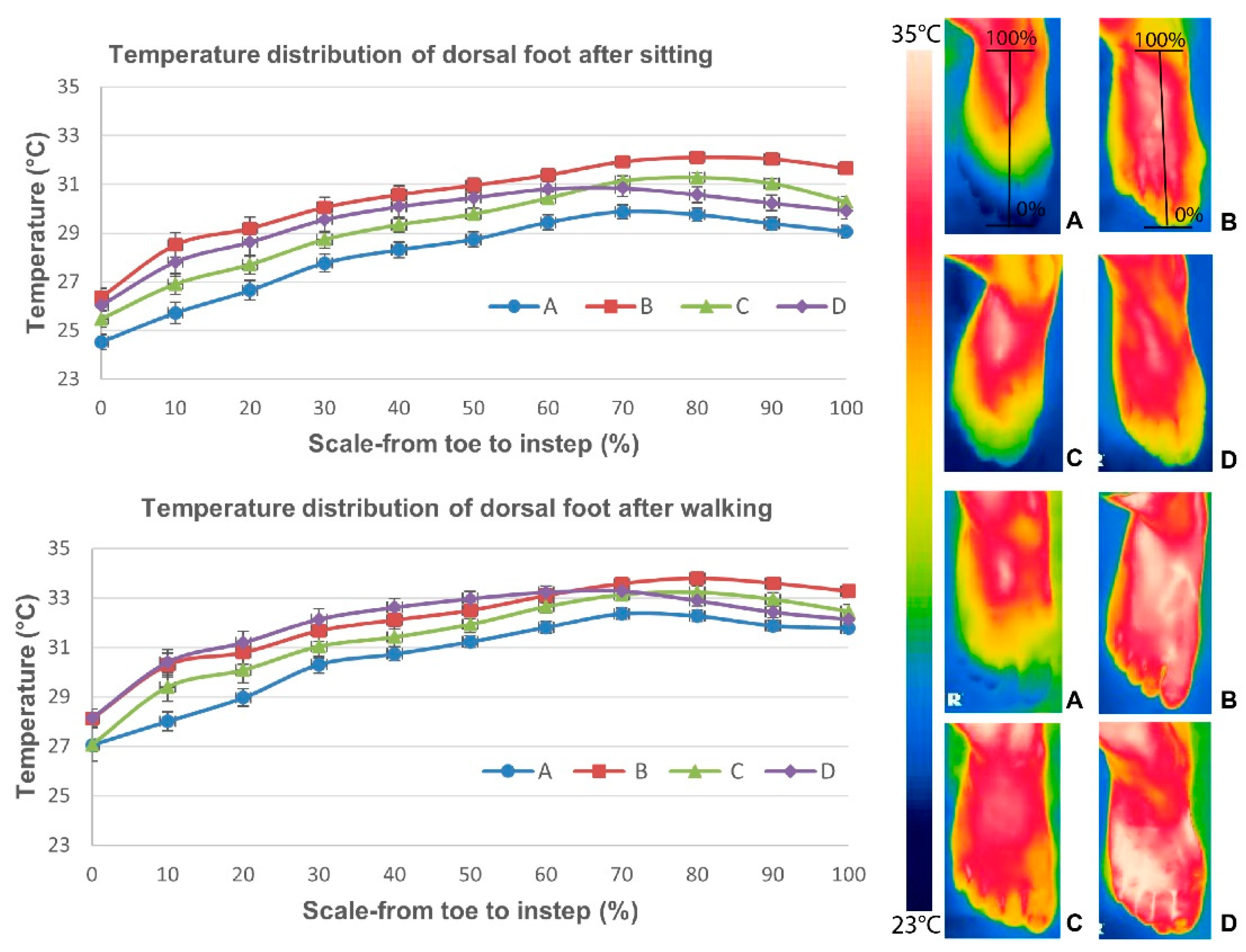

3.2. Changes in Foot Skin Relative Humidity
3.3. Sweat Accumulation in Footwear Conditions
3.4. Subjective Perceptions
4. Discussion
5. Conclusions
Author Contributions
Funding
Institutional Review Board Statement
Informed Consent Statement
Conflicts of Interest
References
- Shimazaki, Y.; Matsutani, T.; Satsumoto, Y. Evaluation of thermal formation and air ventilation inside footwear during gait: The role of gait and fitting. Appl. Ergon. 2016, 55, 234. [Google Scholar] [CrossRef] [PubMed]
- Day, R. Regional heat loss. In Physiology of Heat Regulation and the Science of Clothing; Newburgh, L.H., Ed.; Saunders Co.: Philadelphia, PA, USA, 1969. [Google Scholar]
- Bouskill, L.M.; Havenith, G.; Kuklane, K.; Parsons, K.C.; Withey, W.R. Relationship between Clothing Ventilation and Thermal Insulation. AIHA J. 2002, 63, 262–268. [Google Scholar] [CrossRef] [PubMed]
- Bergquist, K.; Holmér, I. A method for dynamic measurement of the resistance to dry heat exchange by footwear. Appl. Ergon. 1997, 28, 383–388. [Google Scholar] [CrossRef]
- Bhatia, D.; Malhotra, U. Thermophysiological Wear Comfort of Clothing: An Overview. J. Text. Sci. Eng. 2016, 6, 2. [Google Scholar] [CrossRef]
- Havenith, G. Interaction of clothing and thermoregulation. Exog. Dermatol. 2002, 1, 221–230. [Google Scholar] [CrossRef]
- Satsumoto, Y.; Piao, S. Effects of Shoe Fit and Moisture Permeability of a Leather Shoe on Shoe Microclimate and Air Exchange. J. Ergon. 2016, 6, 4. [Google Scholar] [CrossRef]
- Smith, C.J.; Machado-Moreira, C.A.; Plant, G.; Hodder, S.; Havenith, G.; Taylor, N.A.S. Design data for footwear: Sweating distribution on the human foot. Int. J. Cloth. Sci. Technol. 2013, 25, 43–58. [Google Scholar] [CrossRef]
- Taylor, N.A.S.; Caldwell, J.N.; Mekjavic, I.B. The sweating foot: Local differences in sweat secretion during exercise-induced hyperthermia. Aviat. Space Environ. Med. 2006, 77, 1020. [Google Scholar]
- West, A.M.; Tarrier, J.; Hodder, S.; Havenith, G. Sweat distribution and perceived wetness across the human foot: The effect of shoes and exercise intensity. Ergonomics 2019, 62, 1450–1461. [Google Scholar] [CrossRef]
- Collins, K.J.; Weiner, J.S. Observations on arm-bag suppression of sweating and its relationship to thermal sweat-gland ‘fatigue’. J. Physiol. 1962, 161, 538–556. [Google Scholar] [CrossRef]
- Wrobel, J.S.; Ammanath, P.; Le, T.; Luring, C.; Wensman, J.; Grewal, G.S.; Najafi, B.; Pop-Busui, R. A novel shear reduction insole effect on the thermal response to walking stress, balance, and gait. J. Diabetes Sci. Technol. 2014, 8, 1151–1156. [Google Scholar] [CrossRef]
- Irzmańska, E. The Microclimate in Protective Fire Fighter Footwear: Foot Temperature and Air Temperature and Relative Humidity. Autex Res. J. 2016, 16, 2. [Google Scholar] [CrossRef]
- West, A.M.; Schönfisch, D.; Picard, A.; Tarrier, J.; Hodder, S.; Havenith, G. Shoe microclimate: An objective characterisation and subjective evaluation. Appl. Ergon. 2019, 78, 1–12. [Google Scholar] [CrossRef]
- Dufour, A.; Candas, V. Ageing and thermal responses during passive heat exposure: Sweating and sensory aspects. Eur. J. Appl. Physiol. 2007, 100, 19–26. [Google Scholar] [CrossRef]
- Inbar, O.; Morris, N.; Epstein, Y.; Gass, G. Comparison of thermoregulatory responses to exercise in dry heat among prepubertal boys, young adults and older males. Exp. Physiol. 2004, 89, 691–700. [Google Scholar] [CrossRef]
- Kenny, G.P.; Poirier, M.P.; Metsios, G.S.; Boulay, P.; Dervis, S.; Friesen, B.J.; Malcolm, J.; Sigal, R.J.; Seely, A.J.E.; Flouris, A.D. Hyperthermia and cardiovascular strain during an extreme heat exposure in young versus older adults. Temperature 2017, 4, 79–88. [Google Scholar] [CrossRef]
- Larose, J.; Boulay, P.; Wright-Beatty, H.E.; Sigal, R.J.; Hardcastle, S.; Kenny, G.P. Age-related differences in heat loss capacity occur under both dry and humid heat stress conditions. J. Appl. Physiol. 2014, 117, 69–79. [Google Scholar] [CrossRef]
- Millyard, A.; Layden, J.D.; Pyne, D.B.; Edwards, A.M.; Bloxham, S.R. Impairments to Thermoregulation in the Elderly During Heat Exposure Events. Gerontol. Geriatr. Med. 2020, 6, 2333721420932432. [Google Scholar] [CrossRef]
- Balmain, B.N.; Sabapathy, S.; Louis, M.; Morris, N.R. Aging and Thermoregulatory Control: The Clinical Implications of Exercising under Heat Stress in Older Individuals. BioMed. Res. Int. 2018, 2018, 8306154. [Google Scholar] [CrossRef]
- Irzmańska, E.; Brochocka, A.; Majchrzycka, K. Textile Composite Materials with Bioactive Melt-Blown Nonwovens for Protective Footwear. Fibres Text. East. Eur. 2012, 20, 119–125. [Google Scholar]
- Luximon, A.; Ganesan, B.; Younus, A. Effects of Socks and Shoes on Normal Foot Skin Temperature; Springer International Publishing: Cham, Switzerland, 2017; pp. 485–492. [Google Scholar]
- Kong, P.W.; Lim, C.Y.; Ding, R.; Sterzing, T. Subjective evaluation of running footwear depends on country and assessment method: A bi-national study. Ergonomics 2015, 58, 1589–1604. [Google Scholar] [CrossRef]
- Lo, W.T.; Yick, K.L.; Ng, S.P.; Yip, J. New methods for evaluating physical and thermal comfort properties of orthotic materials used in insoles for patients with diabetes. J. Rehabil. Res. Dev. 2014, 51, 311. [Google Scholar] [CrossRef]
- KES-F7; KES-F7 Thermo-Lab-II B: Precise and Fast Thermal-Property Measuring Instrument. Katotech Ltd.: Kyoto, Japan, 1983.
- ASHRAE-Standard 55; ANSI/ASHRAE Standard 55-2010: Thermal Environmental Conditions for Human Occupancy. ASHRAE: Atlanta, GA, USA, 2010.
- ISO Standard 7730; ISO 7730 2005-11-15 Ergonomics of the Thermal Environment: Analytical Determination and Interpretation of Thermal Comfort Using Calculation of the PMV and PPD Indices and Local Thermal Comfort Criteria. ISO: London, UK, 2005.
- Purvis, A.; Tunstall, H. Effects of sock type on foot skin temperature and thermal demand during exercise. Ergonomics 2004, 47, 1657–1668. [Google Scholar] [CrossRef]
- Drzazga, Z.; Binek, M.; Pokora, I.; Sadowska-Krępa, E. A preliminary study on infrared thermal imaging of cross-country skiers and swimmers subjected to endurance exercise. J. Therm. Anal. Calorim. 2018, 134, 701–710. [Google Scholar] [CrossRef]
- Ammer, K. The Glamorgan Protocol for recording and evaluation of thermal images of the human body. Thermol. Int. 2008, 18, 125–129. [Google Scholar]
- Jiang, L.J.; Ng, E.Y.K.; Yeo, A.C.B.; Wu, S.; Pan, F.; Yau, W.Y.; Chen, J.H.; Yang, Y. A perspective on medical infrared imaging. J. Med. Eng. Technol. 2005, 29, 257–267. [Google Scholar] [CrossRef]
- Priego Quesada, J.I.; Lucas-Cuevas, A.G.; Gil-Calvo, M.; Giménez, J.V.; Aparicio, I.; Cibrián Ortiz de Anda, R.M.; Salvador Palmer, R.; Llana-Belloch, S.; Pérez-Soriano, P. Effects of graduated compression stockings on skin temperature after running. J. Therm. Biol. 2015, 52, 130–136. [Google Scholar] [CrossRef]
- Gatt, A.; Formosa, C.; Cassar, K.; Camilleri, K.P.; De Raffaele, C.; Mizzi, A.; Azzopardi, C.; Mizzi, S.; Falzon, O.; Cristina, S.; et al. Thermographic Patterns of the Upper and Lower Limbs: Baseline Data. Int. J. Vasc. Med. 2015, 2015, 831369. [Google Scholar] [CrossRef]
- Roback, K. An overview of temperature monitoring devices for early detection of diabetic foot disorders. Expert Rev. Med. Devices 2010, 7, 711–718. [Google Scholar] [CrossRef]
- Priego Quesada, J.I.; Kunzler, M.R.; da Rocha, E.S.; Machado, Á.S.; Carpes, F.P. Plantar Pressure and Foot Temperature Responses to Acute Barefoot and Shod Running. Hum. Mov. 2015, 16, 142–148. [Google Scholar] [CrossRef][Green Version]
- Shimazaki, Y.; Murata, M. Effect of gait on formation of thermal environment inside footwear. Appl. Ergon. 2015, 49, 55–62. [Google Scholar] [CrossRef]
- Reddy, P.N.; Cooper, G.; Weightman, A.; Hodson-Tole, E.; Reeves, N.D. Walking cadence affects rate of plantar foot temperature change but not final temperature in younger and older adults. Gait Posture 2017, 52, 272–279. [Google Scholar] [CrossRef]
- Shibasaki, M.; Wilson, T.E.; Crandall, C.G. Neural control and mechanisms of eccrine sweating during heat stress and exercise. J. Appl. Physiol. 2006, 100, 1692–1701. [Google Scholar] [CrossRef]
- Lan, L.; Lian, Z.; Liu, W.; Liu, Y. Investigation of gender difference in thermal comfort for Chinese people. Eur. J. Appl. Physiol. 2008, 102, 471–480. [Google Scholar] [CrossRef]
- Havenith, G. Heat balance when wearing protective clothing. Ann. Occup. Hyg. 1999, 43, 289–296. [Google Scholar] [CrossRef]
- Ueda, H.; Inoue, Y.; Matsudaira, M.; Araki, T.; Havenith, G. Regional microclimate humidity of clothing during light work as a result of the interaction between local sweat production and ventilation. Int. J. Cloth. Sci. Technol. 2006, 18, 225–234. [Google Scholar] [CrossRef]
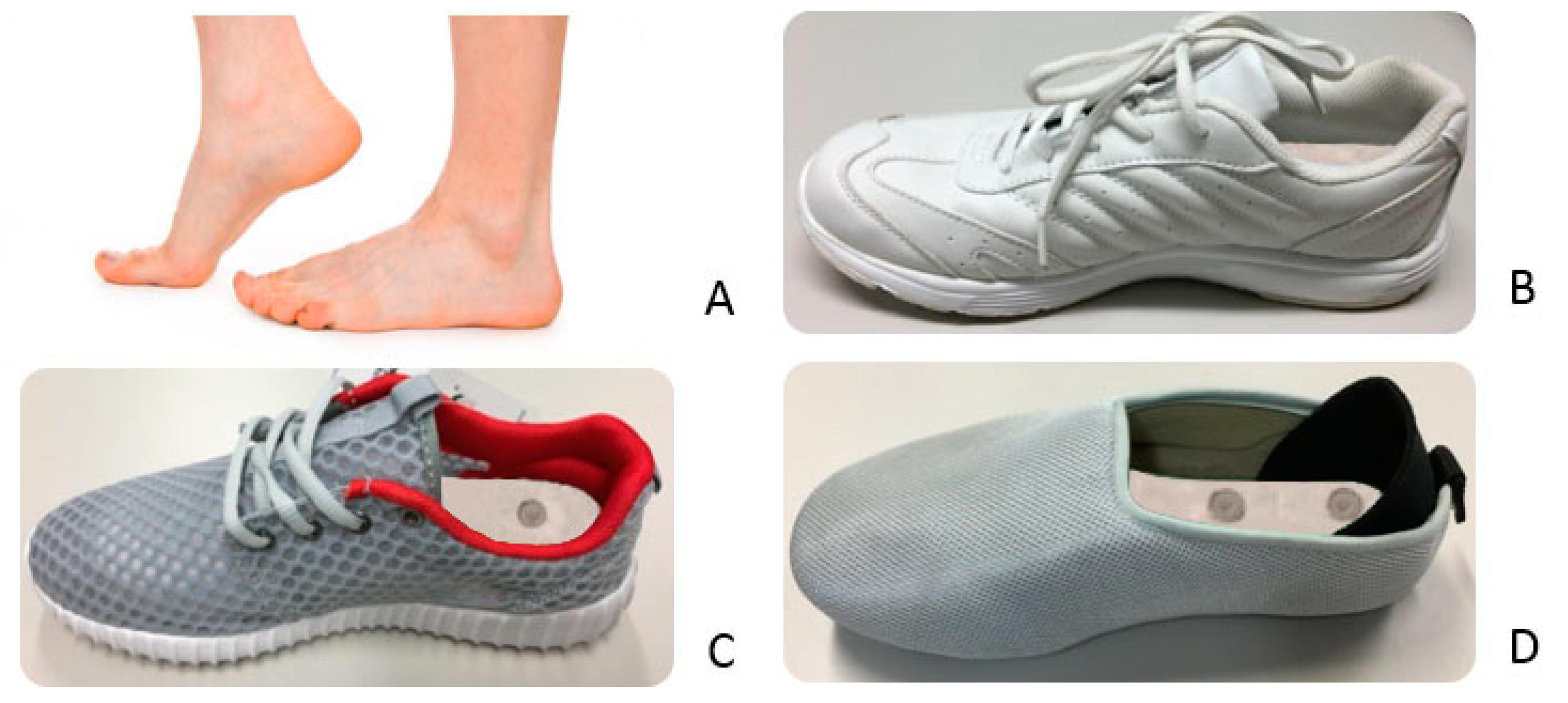

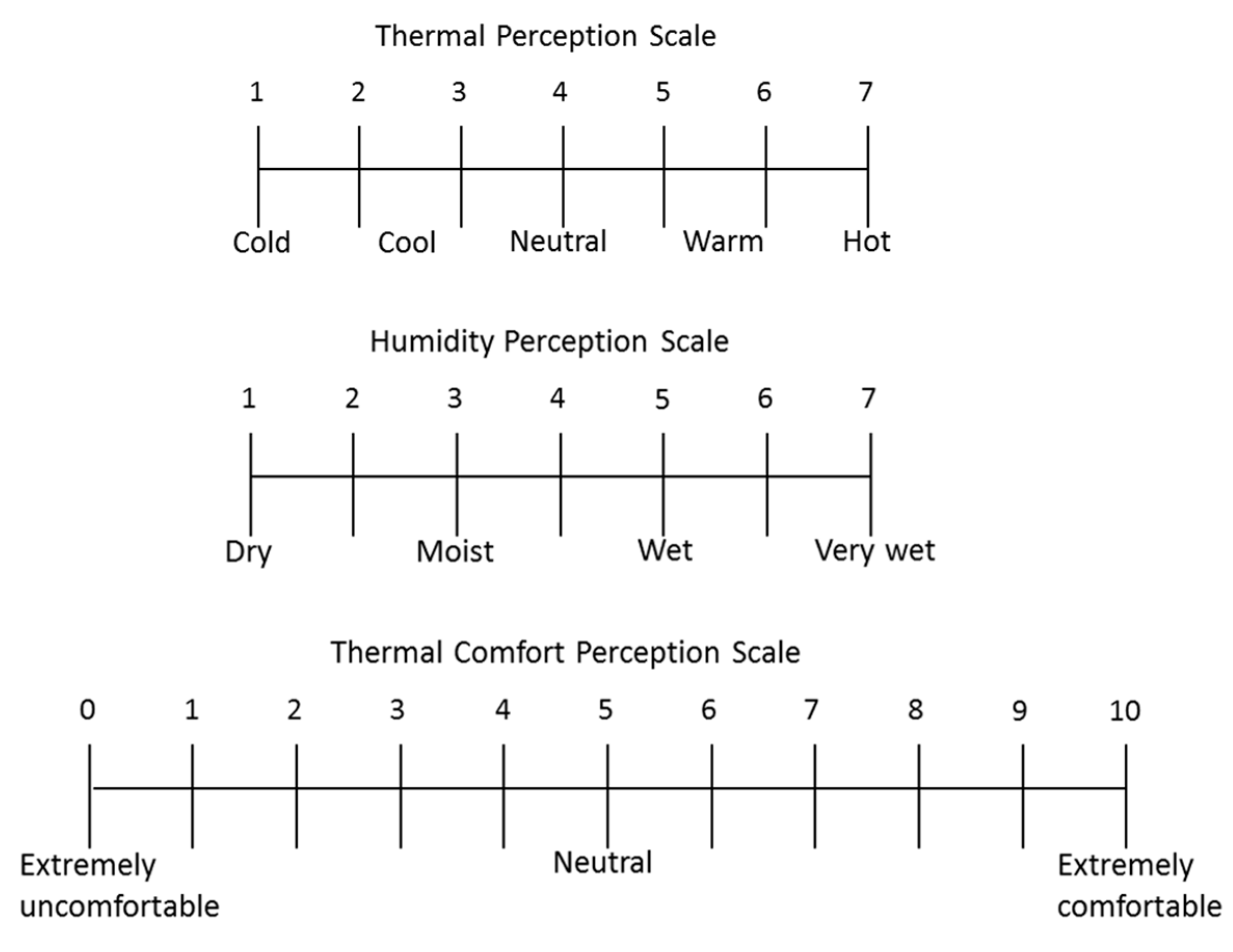
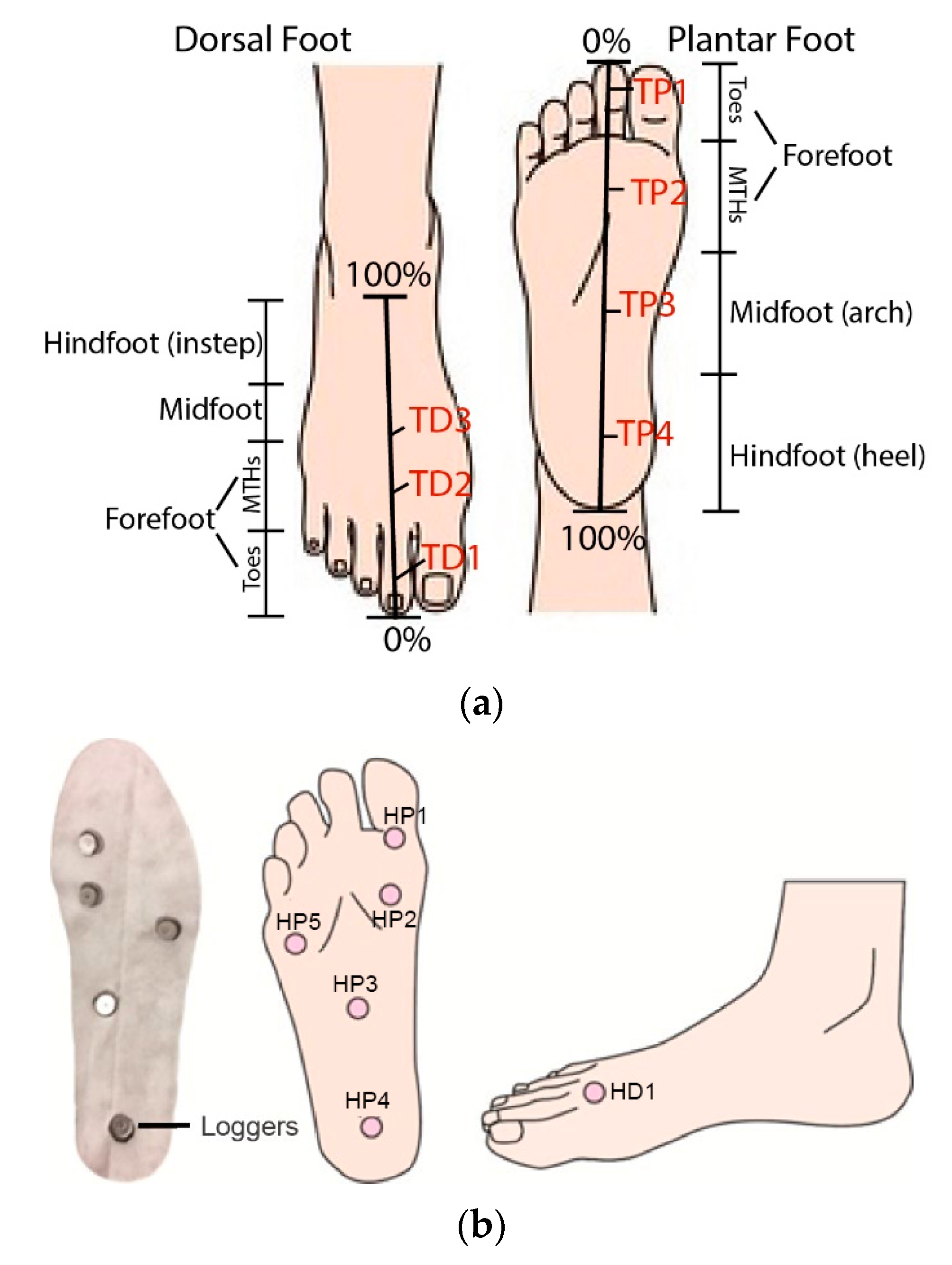

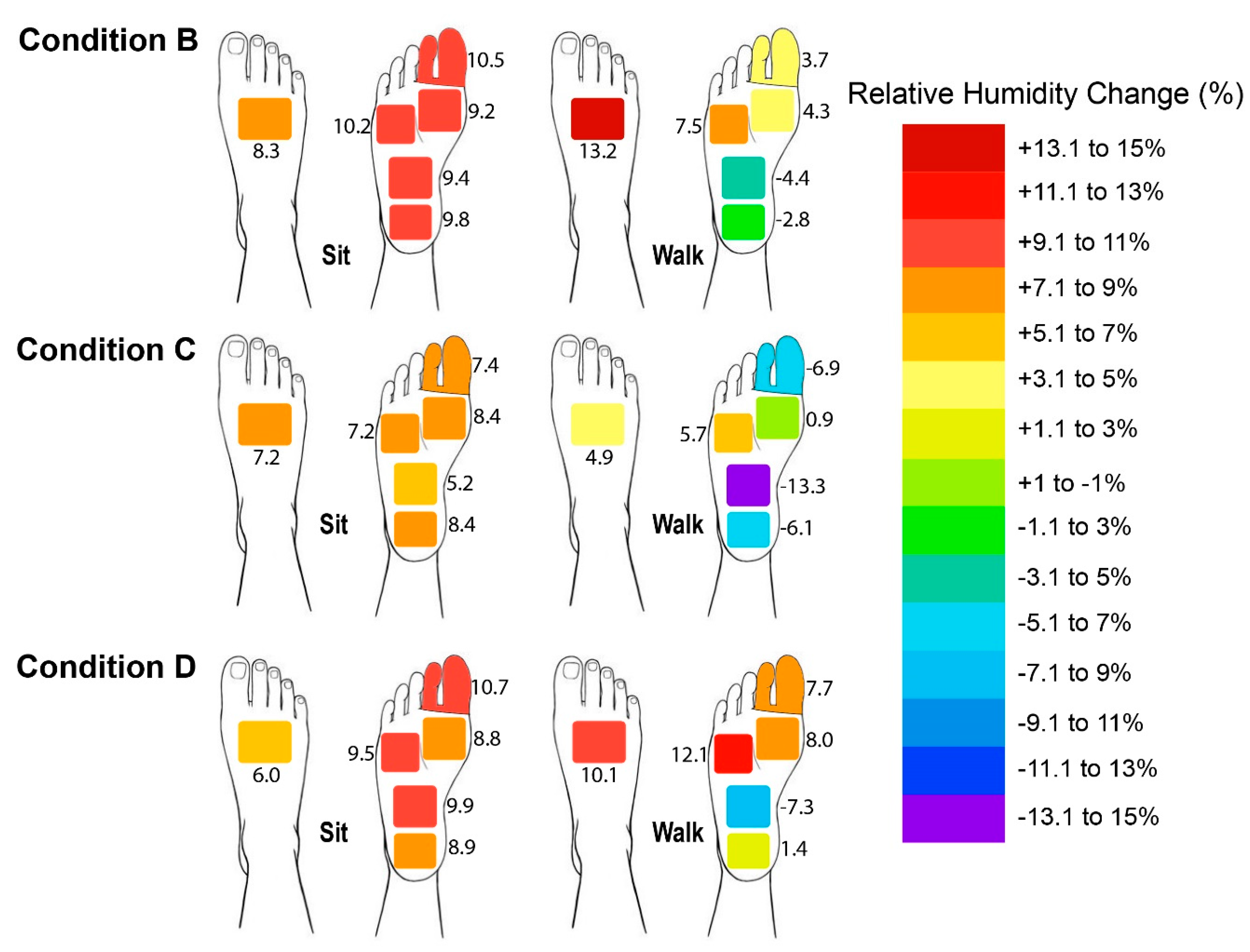
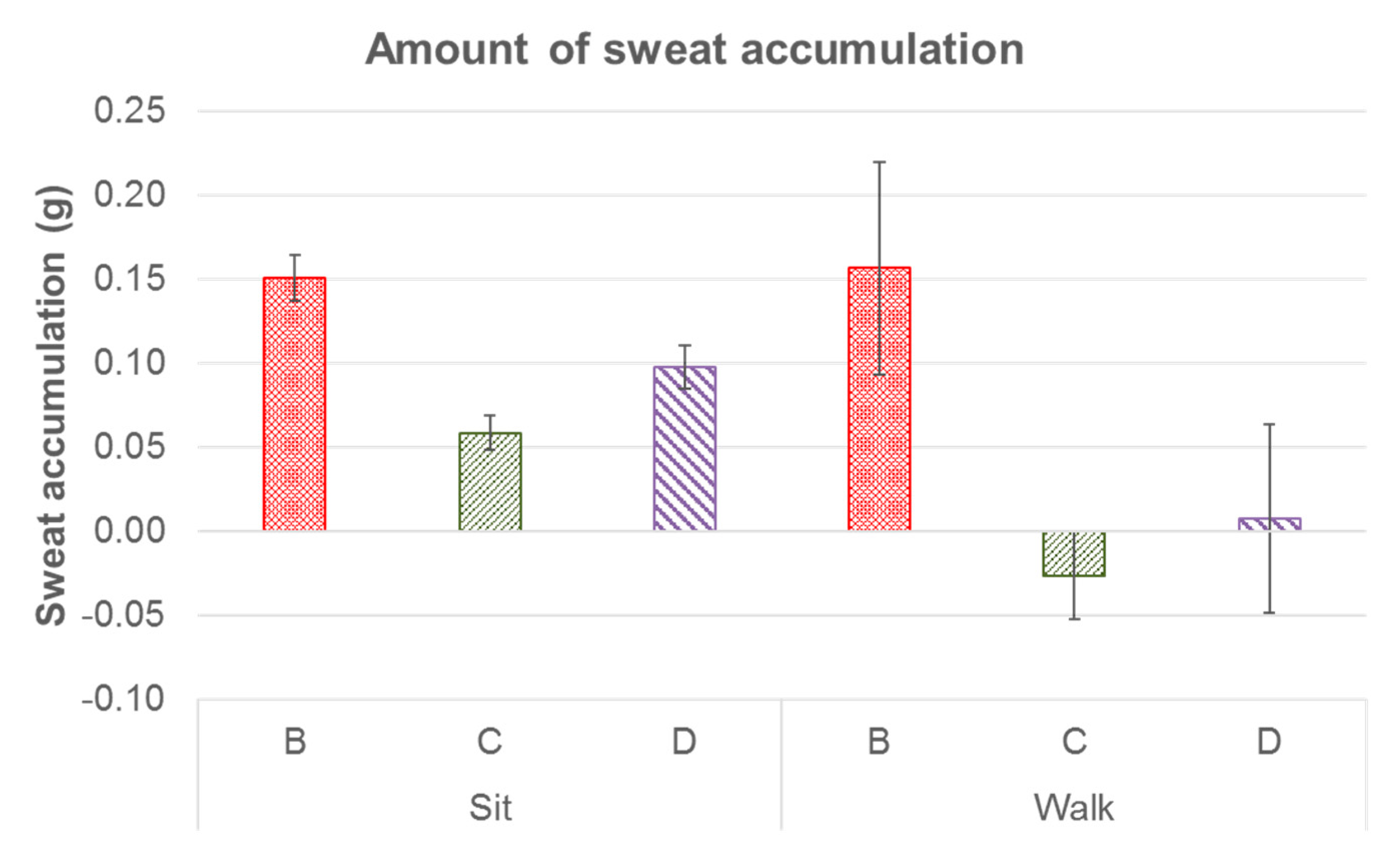
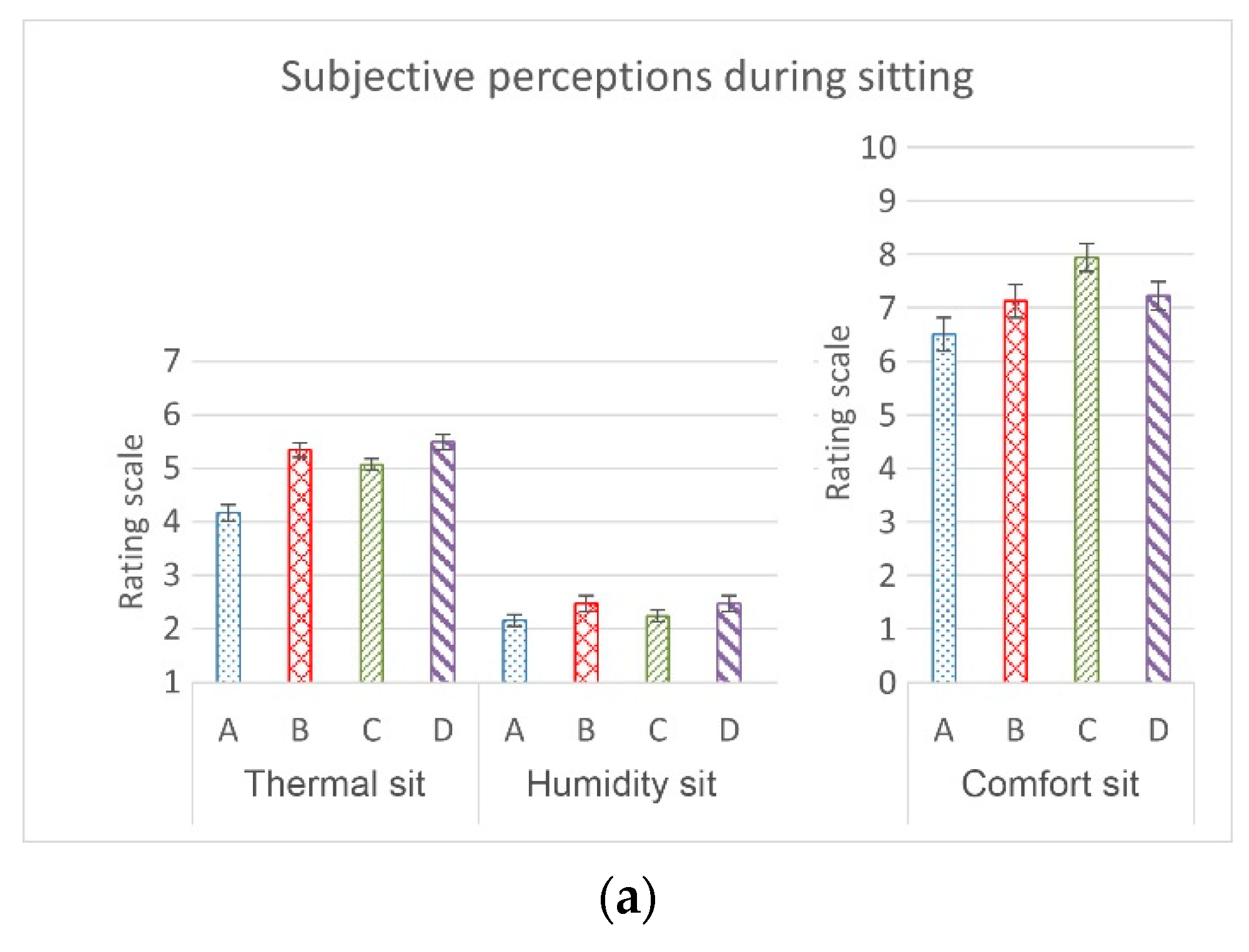
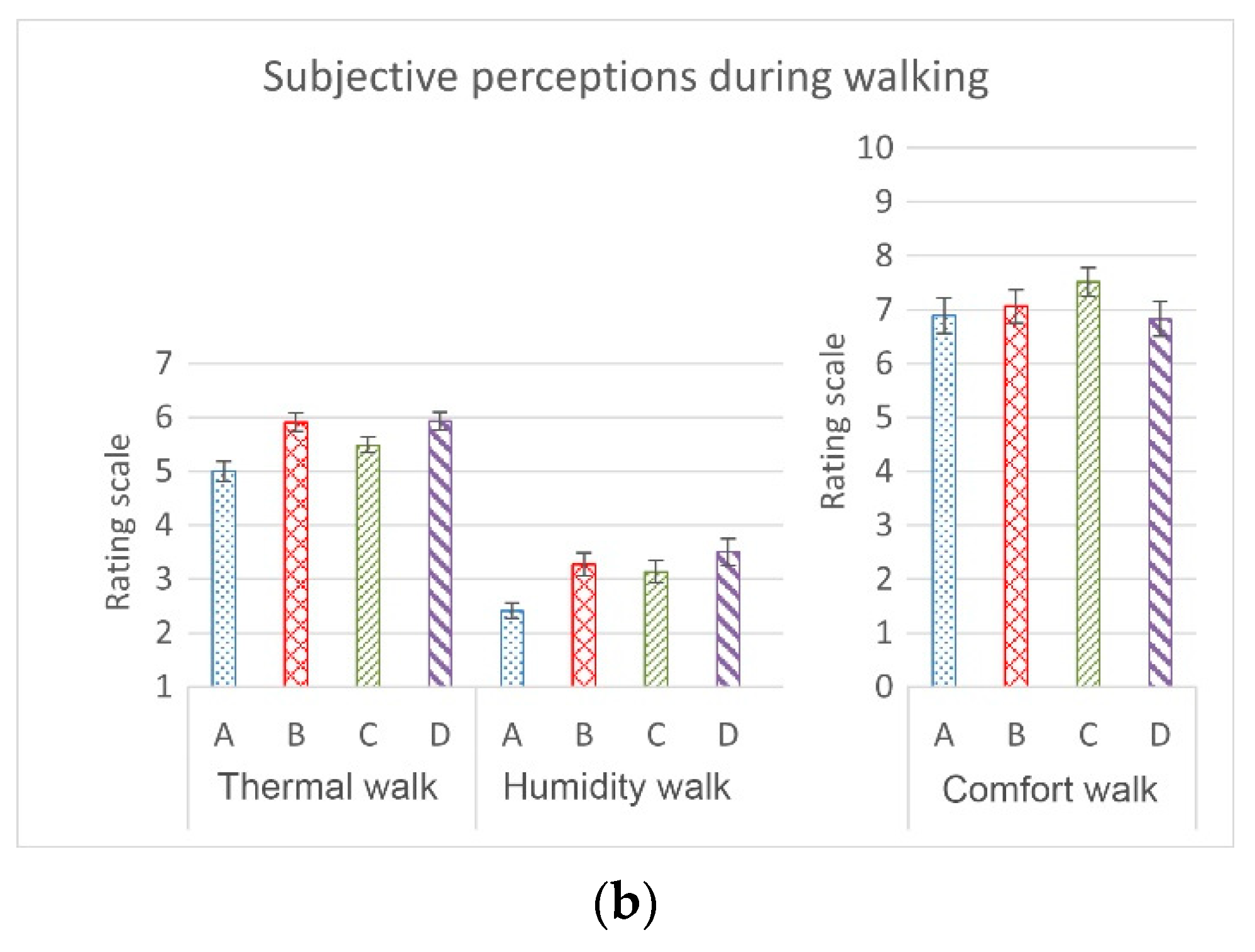
| Footwear Condition B | Footwear Condition C | Footwear Condition D | |
|---|---|---|---|
| Type of fabric | Synthetic leather with foam and lining | Mesh fabric | A combination of woven, foam, and knit (lining) fabrics |
| Thickness (mm) | 4.74 | 1.90 | 6.38 |
| Covered Area—EU 37–43 (cm2) | 498.84–505.24 | 494.26–505.64 | 441.33–445.07 |
| Thermal conductivity KES-F7 (W/cm·K) | 0.040 | 0.042 | 0.034 |
| Thermal insulation KES-F7 -heat retention rate (%) | 53.69 | 42.99 | 68.11 |
| Air resistance KES F8 (kPa·s/m) | - | 0.01 | 0.07 |
| Water vapor transmission rate ASTM E96 (g/m2·h) | 0.84 | 38.06 | 27.01 |
| Factor (n = 40) | |||||||||||
|---|---|---|---|---|---|---|---|---|---|---|---|
| Experimental Condition | |||||||||||
| Location | Length of Activity | Activity | Gender | A and B | A and C | A and D | B and C | B and D | C and D | ||
| Temperature change | Dorsal side | TD1 | 0.096 | 0.005 | 0.757 | <0.001 | 1.000 | 0.006 | 0.140 | 1.000 | 1.000 |
| TD2 | 0.033 | 0.002 | 0.733 | 0.002 | 1.000 | 0.056 | 0.185 | 1.000 | 1.000 | ||
| TD3 | <0.001 | <0.001 | 0.996 | <0.001 | 1.000 | 0.003 | 0.067 | 1.000 | 0.273 | ||
| Plantar side | TP1 | <0.001 | <0.001 | 0.483 | <0.001 | 0.195 | 0.001 | 0.306 | 1.000 | 1.000 | |
| TP2 | <0.001 | <0.001 | 0.737 | <0.001 | 0.009 | <0.001 | 1.000 | 1.000 | 1.000 | ||
| TP3 | <0.001 | <0.001 | 0.632 | <0.001 | <0.001 | <0.001 | 1.000 | 1.000 | 1.000 | ||
| TP4 | <0.001 | <0.001 | 0.589 | <0.001 | <0.001 | <0.001 | 1.000 | 0.357 | 1.000 | ||
| Location | Length of activity | Activity | Gender | A and B | A and C | A and D | B and C | B and D | C and D | ||
| RH change | Plantar side | HP1 | <0.001 | <0.001 | 0.124 | N/A | N/A | N/A | <0.001 | 1.000 | <0.001 |
| HP2 | <0.001 | 0.359 | 0.616 | N/A | N/A | N/A | 0.257 | 1.000 | 0.149 | ||
| HP3 | 0.908 | <0.001 | 0.013 | N/A | N/A | N/A | <0.001 | 0.409 | 0.066 | ||
| HP4 | <0.001 | <0.001 | 0.176 | N/A | N/A | N/A | 0.197 | 0.132 | 0.001 | ||
| HP5 | <0.001 | 0.923 | 0.459 | N/A | N/A | N/A | 1.000 | 1.000 | 1.000 | ||
| Dorsal side | HD1 | <0.001 | 0.255 | 0.075 | N/A | N/A | N/A | 0.405 | 1.000 | 1.000 | |
| Sweat accumulation | N/A | <0.001 | 0.607 | <0.001 | N/A | N/A | N/A | <0.001 | <0.001 | 1.000 | |
Publisher’s Note: MDPI stays neutral with regard to jurisdictional claims in published maps and institutional affiliations. |
© 2022 by the authors. Licensee MDPI, Basel, Switzerland. This article is an open access article distributed under the terms and conditions of the Creative Commons Attribution (CC BY) license (https://creativecommons.org/licenses/by/4.0/).
Share and Cite
Li, P.-L.; Yick, K.-L.; Yip, J.; Ng, S.-P. Influence of Upper Footwear Material Properties on Foot Skin Temperature, Humidity and Perceived Comfort of Older Individuals. Int. J. Environ. Res. Public Health 2022, 19, 10861. https://doi.org/10.3390/ijerph191710861
Li P-L, Yick K-L, Yip J, Ng S-P. Influence of Upper Footwear Material Properties on Foot Skin Temperature, Humidity and Perceived Comfort of Older Individuals. International Journal of Environmental Research and Public Health. 2022; 19(17):10861. https://doi.org/10.3390/ijerph191710861
Chicago/Turabian StyleLi, Pui-Ling, Kit-Lun Yick, Joanne Yip, and Sun-Pui Ng. 2022. "Influence of Upper Footwear Material Properties on Foot Skin Temperature, Humidity and Perceived Comfort of Older Individuals" International Journal of Environmental Research and Public Health 19, no. 17: 10861. https://doi.org/10.3390/ijerph191710861
APA StyleLi, P.-L., Yick, K.-L., Yip, J., & Ng, S.-P. (2022). Influence of Upper Footwear Material Properties on Foot Skin Temperature, Humidity and Perceived Comfort of Older Individuals. International Journal of Environmental Research and Public Health, 19(17), 10861. https://doi.org/10.3390/ijerph191710861






